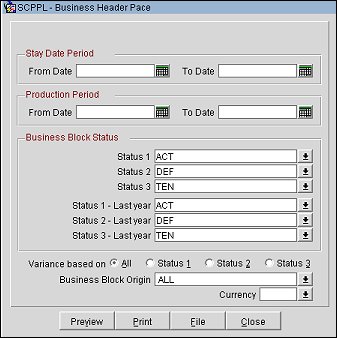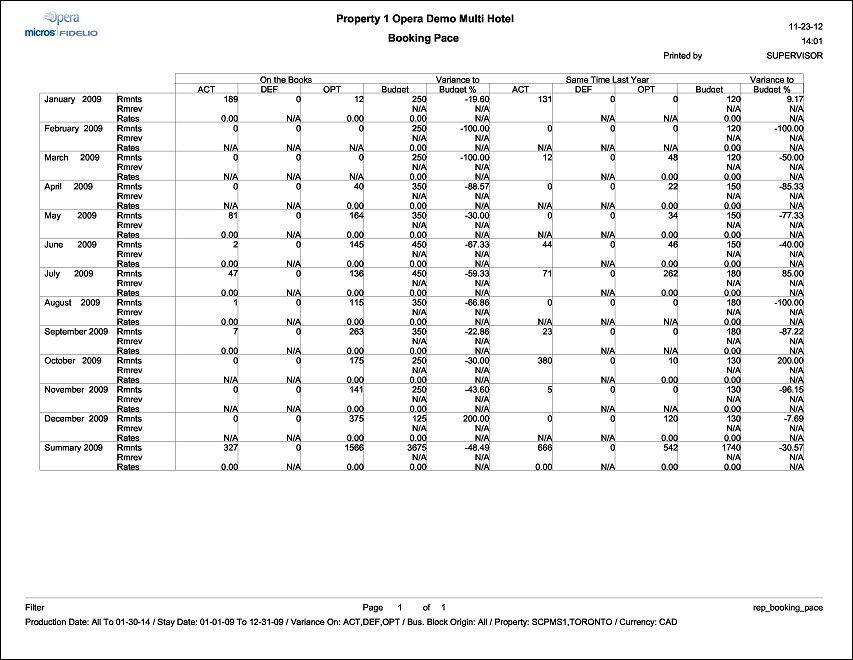
Booking Pace Report (REP_BOOKING_PACE.REP with REP_BOOKING_PACE.FMX)
This report displays the booking production for a certain time period compared to budgeted room nights and revenue for the same stay date period and another comparison to the production for the same stay date range last year. The produced room nights, revenue and average rate are grouped by stay date periods (either calendar month or fiscal period, depending on the hotels configuration). The report can be run for a limited production period i.e. 01.June 2003 to 30.June 2003 which would only show the production during that time frame. Alternatively the report can be run with the production date range left blank, which would represent groups rooms and revenue for the stay date range at the moment of printing (also known as on-the-books).
This report operates without a defined credit status and therefore will only ever report on the last status that a booking is on during the production period. For example, if the report is run for production period June 2003 and we have a booking that was created with 10 rooms @ 100.00 USD rate on status TEN on the 02.June 2003, turned DEF on the 10.June 2003 and arrived and became ACT on the 20 June 2003, the 10 rooms and according revenue will ONLY appear in the column for status ACT, which was the LAST status this booking was on in the reported production period. This is important to note when comparing this report to other production reports like the Backlog report (REP_BACKLOG) and Business Block Production report (REP_PROD_CH) which operate with a credit status and could therefore count the booking twice, once in the defined credit status (usually DEF) and once in the last status (here ACT) if the booking passed both statuses in the production period.
This report will therefore not ’balance’ to the formerly mentioned other report when comparing the credit status figures.
Note: When printing this Report help topic, we recommend printing with Landscape page orientation.
Note: This report requires that the user be granted the BLOCK PRINT permission in the selected property to run the report. Also, the Property LOV in this report is further limited by the properties to which the user has the appropriate access granted.

Property. Available when OPS_MHT2 license is active. Choose the property for which the report should be printed.
Stay Date Period
From Date/To Date. The stay date range that should be covered in this report. If the Stay Date From Date is 01 January 2013 and the Stay Date From Date is 31 December 2013, if a booking exists that arrives on 27 December 2012 and stays until the 15 January 2013, those room nights and revenues that pertain to the stay dates of this booking in January 2013 (01 to 15) will be included in this report. This occurs even though the arrival date of the booking is NOT between the Stay Date From Date and the Stay Date To Date specified.
Production Period
From Date/To Date. Defines the date range for which booking changes should be recorded. Each change that is done to a booking status, or booking room nights and revenue, is recorded in a specific production change log. The Production Date Range filter will scan the entries in this production change log to search for any booking changes that fall under the other criteria that have been selected on the filter form. By the nature of this date range filter, only dates in the past are valid entries, because there cannot be any entries in the booking change log after the current business date. To illustrate the above: A booking that gets created on status TEN in April 2003 with Stay Dates in October 2003 can turn to status DEF in June 2003. In the above scenario there would be two entries in the change log for this booking, one for the creation of the booking on status TEN in production period April 2003 and one for the status change to DEF in June 2003.
If the production period is left blank on this report, the figures would automatically print for everything that has been produced for the selected stay date period ever – which is concurrent with the on-the-books figures for group rooms and revenue at the selected statuses at the time or printing the report.
Business Block Status
Status 1- 3. Allows a selection of up to three different status columns to print onto the report. Please keep in mind that, as explained above, this report will ONLY report a booking under the last status that it was in the production period. If a booking turned DEF and ACT in the selected production date range, it will on this report ONLY be reported in the ACT column, not in both DEF and ACT.
Status 1 to 3 – Last Year. Allows the selection of up to three different status columns to print for the production in the same production date range and stay date range one year back. It makes most sense to select the same status code that got selected for the current production period in order to compare last year's production to the current production within the same status codes.
Variance based on Status 1, 2 , 3 or All. Which status column should the variance to budget be calculated for on the report. Typically this variance would be compared to a combination of DEF and ACT bookings.
Business Block Origin. Select the down arrow to choose one or more of the following (available values depend on the active modules and licenses):
Currency. Select the currency you want to be used for calculating the figures in this report. All figures will be reported in the selected currency. If no value is selected, the report will be calculated using the Base Currency of the logged in Property.
Preview. Use the preview option to view the generated output of this report in PDF format.
Print. Use the Print button to print the report to the selected output.
File. Prints the generated report output to an *.rtf file.
Close. Closes this report screen.
The first three columns of the report show the produced number of room nights, room revenue and average rate by status for each calendar month in the selected stay date range. Please note that the revenue and average rate is reported as it appears in the room grid on the booking up to status DEF. No taxes or packages that might be included in the rate are deducted. For ACTUAL bookings, the picked-up number of rooms and the pick-up revenue and average rate are calculated. Revenue and average rate in actual figures are reported NET of taxes or package elements.
Note: Each booking will only ever appear for one of the selected status codes, namely the last one that it was on at the end of the production period. No booking will be recorded under i.e. DEF and ACT status columns, even if it passed through the DEF status into the ACT status during the selected production period.
The next two columns of this report represent the budget figures that have been entered for the stay date range that the report is run for, as well as the difference of the current produced figures to the budget figures, depending on which status column has been selected on the filter form for comparison.
The next three columns show the production of the same production period exactly one year back. If the current production period is June 2003 for stays dates June 2003 to December 2003, the last year columns will calculate the production in June 2002 for stay dates June 2002 to December 2002.
The final two columns show the budget for last year and the variance of the produced figures versus the budgeted figures last year.
The report will fit exactly 12 calendar months and a summary line per calendar year onto each page, printed in landscape format.
